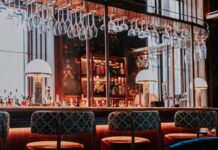The Family Kitchen & Shop at Kew Gardens designed by architects HOK with front of house interiors by Mizzi Studio and Lumsden Design, is an environmentally driven, education-led food space for visitors of all ages.
The restaurant has been designed as a highly sustainable timber building that aligns with the sustainability ethos of the Royal Botanic Gardens, Kew; its interiors present a world of fantasy – a colourful, interactive space that teaches families all about the origins of their food.

In a truly collaborative approach, the Family Kitchen & Shop, designed by HOK’s London studio with the front of house design by Mizzi Studio and Lumsden Design, with design development, interior design and D&B delivery by CityAxis with Mulroy Architects, have created a building of the highest quality, successfully collaborating with RBG Kew to design an environment that stimulates, educates and engages children of all ages. HOK’s brightly sunlit building celebrates the beauty of exposed timber – a material with exemplary sustainability credentials that has been shown to reduce stress and lower the response of the sympathetic nervous system. Raw, tactile and robust materials provide the canvas with construction techniques demonstrated through exposed detailing and materiality. On entering the building, children visiting the Family Kitchen & Shop will be surrounded by a fantastical front of house interior design by Mizzi Studio, with exciting and interactive structures that double up as seats, tables, worktops, lights and educational tools. Finally, families will be able to visit a Kew Gardens’ newest retail space – a colourful, welcoming and open space designed by Lumsden Design.
Reflecting nature in the built environment – HOK’s sustainable timber restaurant
Building on the success of the recently opened Children’s Garden , the primary destination for families visiting Kew Gardens, the new project aims to educate children in the value of healthy eating, good food preparation, the origins of ingredients and natural produce.
Providing 250 covers, the new 1,150m² sustainable facility has been conceived out of a desire by the Royal Botanic Gardens, Kew to enhance the experience of children and their families visiting the Gardens. Following the recent completion of the hugely successful Children’s Garden, a delightfully engaging and interactive playground, the Family Kitchen & Shop will provide a dining experience suitable for a younger audience. The restaurant will open onto an outdoor dining area, bridging the gap to the Children’s Garden, creating a safe and secure zone for children to play, learn and dine within the supervision of their families and Kew Gardens staff.
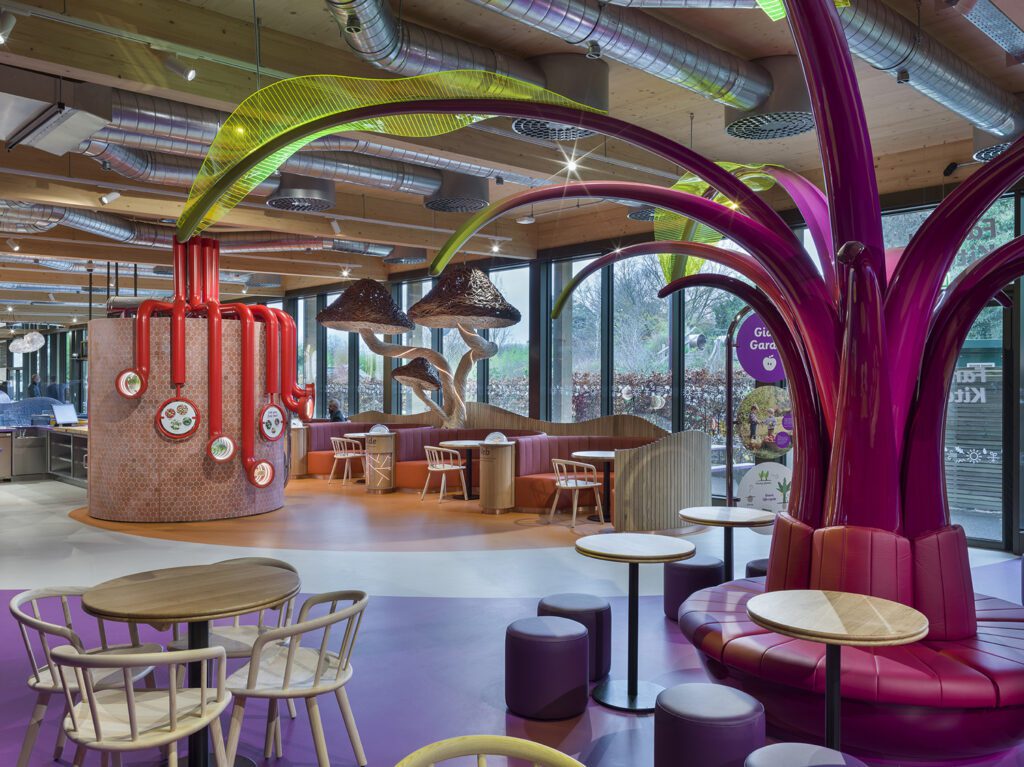
The architecture of the building tells the story of sustainable, flexible and timeless design and is critically honest in its approach. Overarching structural timber elements provide the rhythm of the design, reflecting the common language of various buildings and landscapes within Kew Gardens. The Family Kitchen & Shop will become a key part of the Kew’s education programme as well as enhancing the visitor experience.
An important driver for the project team and client alike was the promotion of sustainable construction techniques and materials. As such the restaurant and retail spaces have been designed with exposed timber structural elements (glu-lam beams, CLT walls and CLT soffit), exposed mechanical and electrical services, triple glazed curtain wall façade, finishes made from recycled materials and an array of photo-voltaic panels on the roof.
In accordance with the Kew’s commitment to become ‘Climate Positive’ by 2030, the building services strategy has been developed to reduce the energy consumption of the building throughout its lifespan. Photovoltaic panels on the roof and a heat recovery system, amongst other measures, contribute to the efficient ongoing operation and maintenance of the building. Thanks to the skill and determination of the design and delivery team, the Family Kitchen & Shop building is on target to achieve BREEAM Excellent certification and boasts an embodied carbon reduction of more than 50 percent against industry benchmarks.
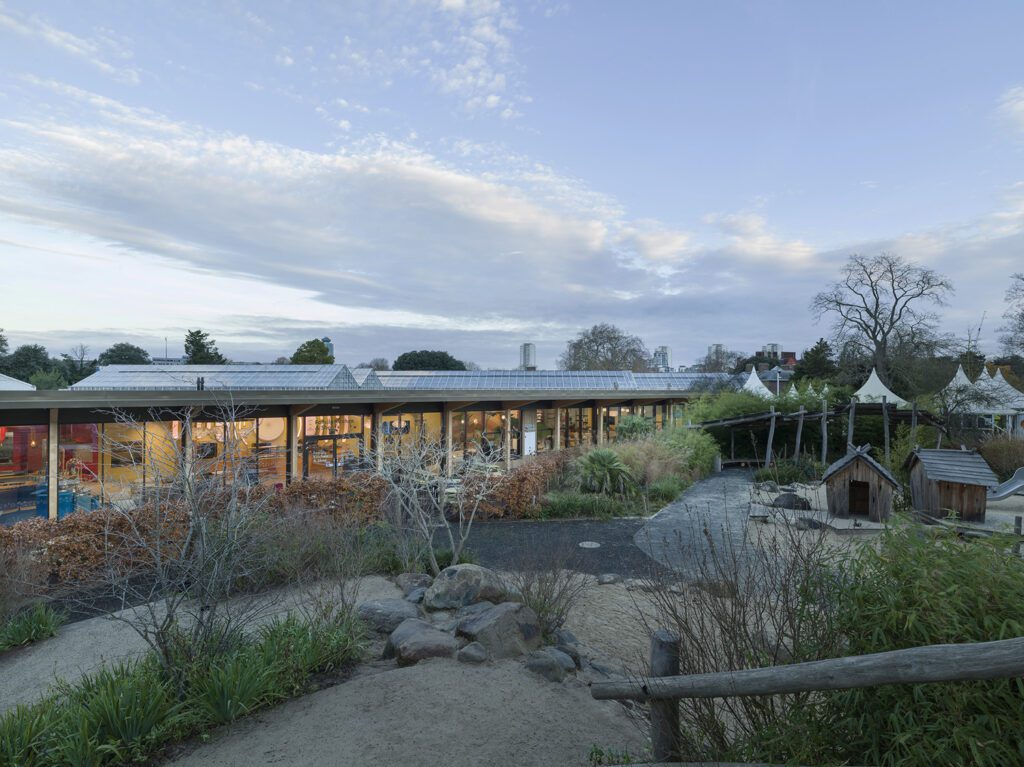
HOK, Associate Stuart Ward said: “We have always seen the Family Kitchen & Shop as an extension of the Children’s Garden and as such transparency, materiality and form were the key drivers for the building design. The elegant timber frame accommodates a flexible front of house space which can take on multiple layouts and is inherently future proof. The regular rhythm of the fully glazed main façade is a nod to the existing architecture elsewhere in the Gardens and the exposed timber offers a visual and tactile link to the natural world.”
“Sustainability is at the forefront of the client’s approach to its global research, and it was important this exciting new facility worked hard to reflect this ethos. We have utilised raw, tactile and robust materials with exposed detailing to create a space that is honest in its approach while promoting responsible and sustainable design and construction techniques. Apart from being renewable, one of timber’s most unique features is the fact that it’s a carbon negative option given the material both absorbs atmospheric carbon and creates considerably lower volumes of emissions during the manufacturing process.”
Fantasy meets nature – Mizzi Studio’s educational, interactive interiors
The spirit of the Family Kitchen & Shop can be described as ‘Charlie and the Chocolate Factory meets nature-led laboratory’. Families will be drawn inside the restaurant by a radiating LED sun, beginning an exciting journey that introduces them to all the natural elements involved in the ecosystem and process of food growth – from the power and energy of the sun to the lessons of seasonality in production and harvesting, each illustrating the path from plant to plate.
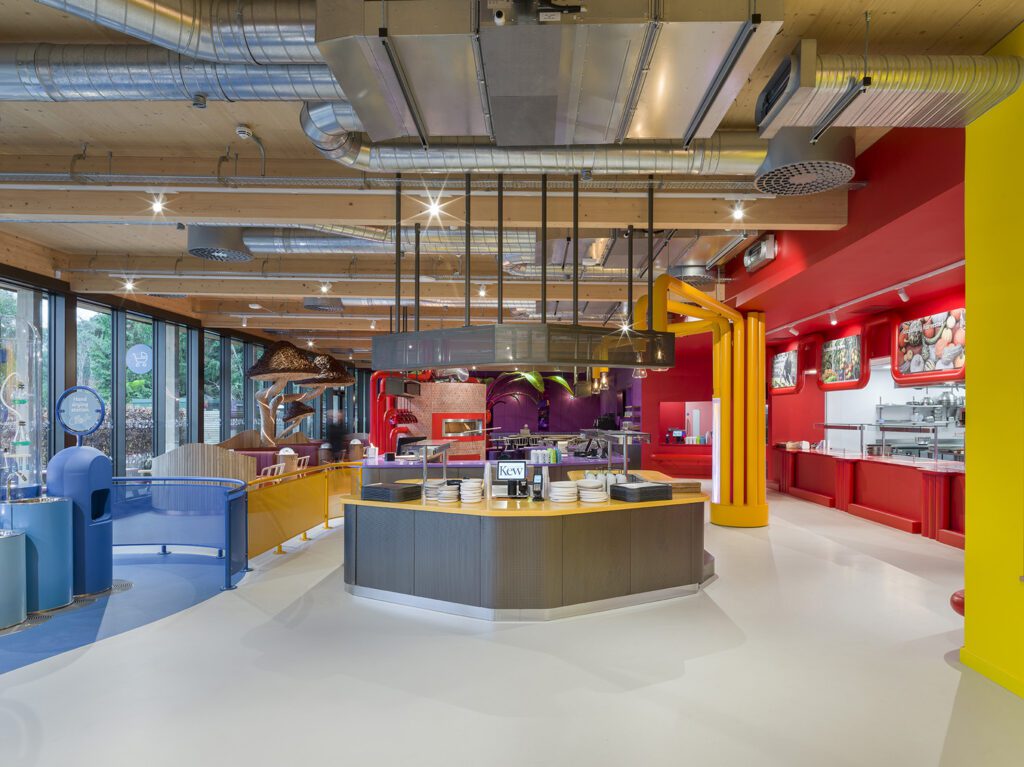
The front of house interiors have been designed to create a magical world of gardens, forests and woodlands where human beings appear to have been shrunk to the size of small creatures living within nature. This vibrant, stimulating world aims to promote the global research undertaken by RBG scientists, and the importance of diet, in an interactive, theatrical and learning-based setting.
The journey begins with a radiating LED sun wall, soft pendant cloud lights, and Gaudi inspired wave seats of blue mosaic that represent the parting seas, introducing visitors to the fundamental elements of nature involved in food growth. Next, families are led to a laboratory-inspired botanical hand washing station, highlighting the importance of hygiene as well as the antibacterial properties of plants like lavender and rosemary. The process of germination and the magic of seeds is brought to life in the green zone dedicated to spring, where lenticular panels and LED-lit push buttons animate the process of seed growth and dispersal.
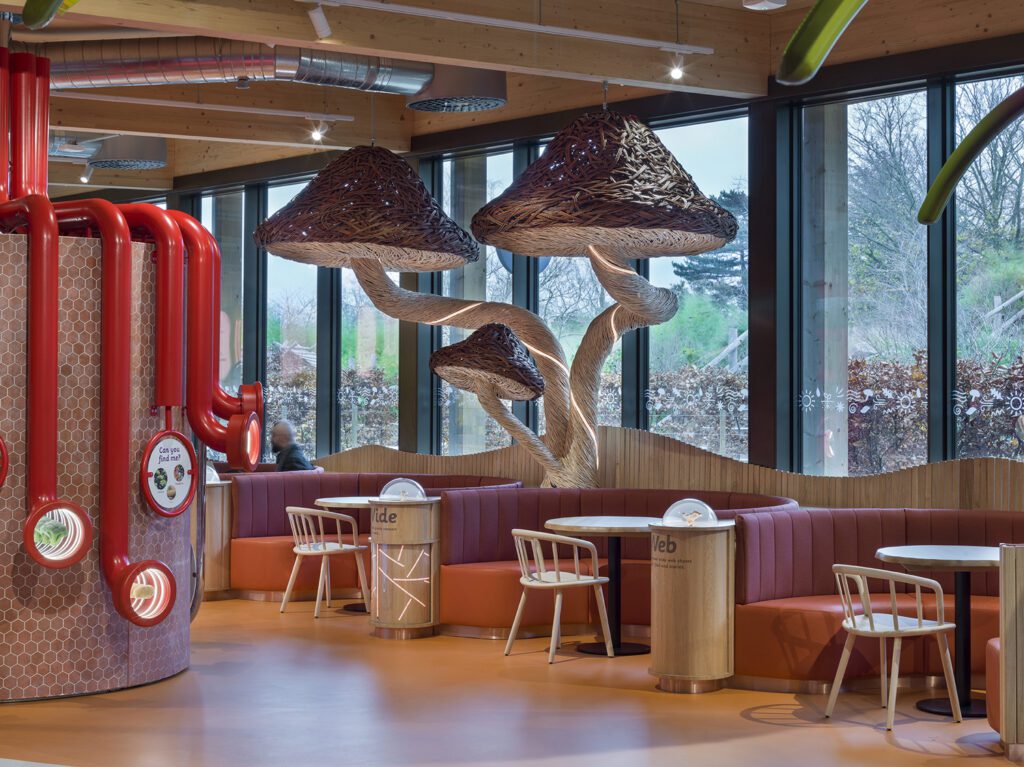
A tiled pizza oven, draped with bright red infinity mirror periscopes that showcase fruit and vegetables, sits in the centre of the Family Kitchen, where children will learn all about how food is made, where ingredients come from, and how to recognise and name the different foods that make up their meals. A pizza topping station allows children to select their own ingredients, pushing knowledge around the process of food making to the front-and-centre of the dining experience. Finally, families will enter the large deep magenta dining zone furnished with an oversized Enset tree and giant apple seat, surrounded with mirrors, illuminated foliage and colourful seating.
The journey’s zoning approach also follows the theme of the earth’s four seasons, with applicable colour stories and textures characterising the different sections and seating throughout the restaurant. In the autumnal section, artist Tom Hare has created large-scale, timber-weaved fungi sculptures, celebrating the magical world of mushrooms, their place in the ‘wood-wide-web’, and their significant role in the mycelium networks in woodlands and forests. Elsewhere, restaurant colours draw from the natural hues and tones of each season, functioning both as wayfinding and playful décor.
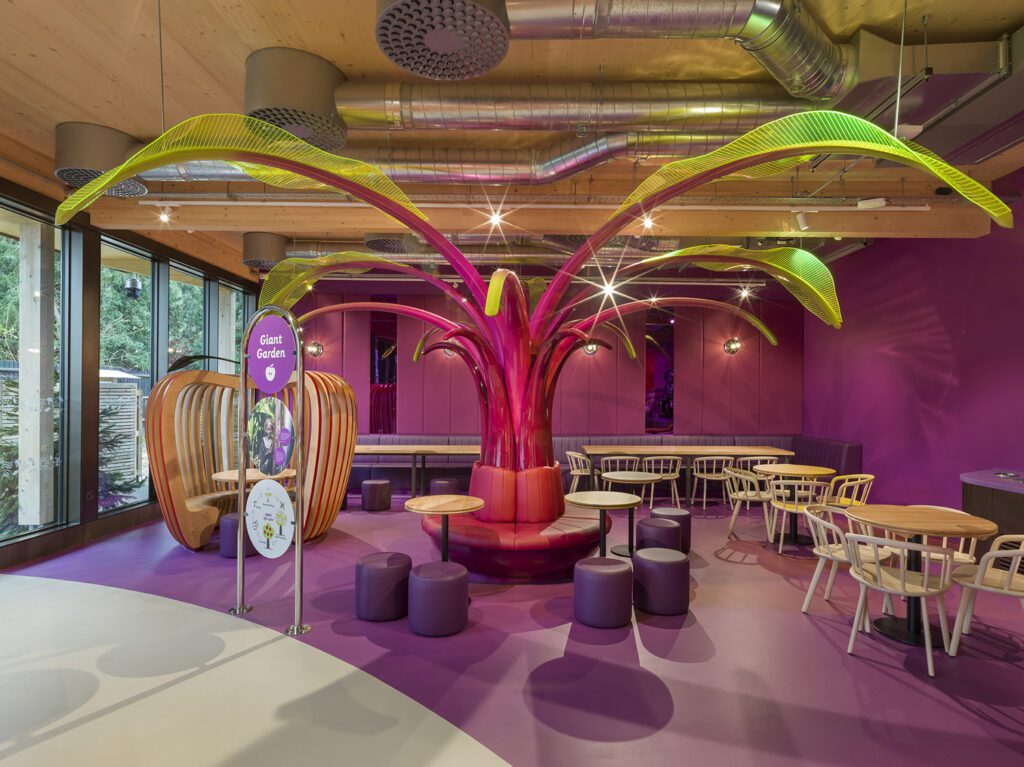
Mizzi Studio, Jonathan Mizzi, Director commented: “Kew is an institution that has brought so much value to the entire world. Our goal has been to design a space that celebrates nature and learning, helping to make children and parents excited about food growth, hygiene and preparation. Through colour, texture and wild nature-inspired form, we have created a space that brings families closer to the roles of the elements in nature, to seasonality, and the overall journey from plant to plate. The Family Kitchen & Shop is a place where the entire family can learn about our ecosystem – how the sun works, how plants work, and how food is grown. As we are living in a climate crisis, Mizzi Studio believes that nothing is more important than using design to champion humanity’s role as stewards of our great and beautiful planet. Our goal is therefore to help children fall in love with nature, so that they will instinctively treasure and protect it as they grow.”
Retail Shop
In collaboration with architects HOK, as well as restaurant designers Mizzi Studio, the team at Lumsden Design has created a unique space full of stories about nature. From display tables resembling oversize ants, to a reading area with an oversize earthworm bench for little bookworms, as well as sculptural honeycomb hive lighting and cloud shaped lights, everywhere you look is designed to fascinate and inspire children and their families.
The shop makes inventive use of sustainable materials throughout, including a cash wrap countertop made from recycled yoghurt pots and sculptural mushroom shaped tables made from trees felled at Kew Gardens during Arboretum maintenance. This unique and ground-breaking space reflects the core values of the Family Kitchen concept and enhancing visitors’ experience of this iconic destination.

James Dwyer, Design Director said: “Kew Gardens has always been a place of magic and inspiration for children and their families,” says James Dwyer, Design Director at Lumsden Design. “So it was a privilege to be asked to create a retail space to complement the new Children’s Garden.”
“All too often the retail space at visitor attractions is an afterthought, a missed opportunity. Our mission is to change that, creating spaces that not only drive significant revenue but also enhance the visitor experience. I believe that’s what we, together with our brilliant client and design partners, have achieved at Kew. I can’t wait for the doors to be opened and the first families begin to discover the space.”

Publisher of Hospitality and Leisure News, 365 Retail, Retail Source and organiser of the Creative Retail Awards.




